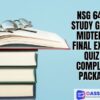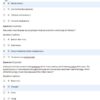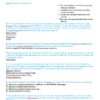Description
NSG 6420 Midterm Exam with Answers
- Your patient has been using chewing tobacco for 10 years. On physical examination, you observe a white ulceration surrounded by erythematous base on the side of his tongue. The clinician should recognize that very often this is: (Points : 2)
- Which of the following would be considered a “red flag” that requires more investigation in a patient assessment? (Points : 2)
- The pathophysiological hallmark of ACD is: (Points : 2)
- It is important to not dilate the eye if ____ is suspected. (Points : 2)
- A 66-year-old patient presents to the clinic complaining of dyspnea and wheezing. The patient reports a smoking history of 2 packs of cigarettes per day since age 16. This would be recorded in the chart as: (Points : 2)
- When teaching a group of older adults regarding prevention of gastroesophageal reflux disease symptoms, the nurse practitioner will include which of the following instructions? (Points : 2)
- A 56-year-old male complains of anorexia, changes in bowel habits, extreme fatigue, and unintentional weight loss. At times he is constipated and other times he has episodes of diarrhea. His physical examination is unremarkable. It is important for the clinician to recognize the importance of: (Points : 2)
- Dan G., a 65-year-old man, presents to your primary care office for the evaluation of chest pain and left-sided shoulder pain. Pain begins after strenuous activity, including walking. Pain is characterized as dull, aching; 8/10 during activity, otherwise 0/10. Began a few months ago, intermittent, aggravated by exercise, and relieved by rest. Has occasional nausea. Pain is retrosternal, radiating to left shoulder, definitely affects quality of life by limiting activity. Pain is worse today; did not go away after he stopped walking. BP 120/80. Pulse 72 and regular. Normal heart sounds, S1 and S2, no murmurs. Which of the following differential diagnoses would be most likely? (Points : 2)
- A common auscultatory finding in advanced CHF is: (Points : 2)
- Which of the following symptoms is common with acute otitis media? (Points : 2)
- Rheumatic heart disease is a complication that can arise from which type of infection? (Points : 2)
- In examining the mouth of an older adult with a history of smoking, the nurse practitioner finds a suspicious oral lesion. The patient has been referred for a biopsy to be sent for pathology. Which is the most common oral precancerous lesion? (Points : 2)
- Jenny is a 24 year old graduate student that presents to the clinic today with complaints of fever, midsternal chest pain and generalized fatigue for the past two days. She denies any cough or sputum production. She states that when she takes Ibuprofen and rest that the chest pain does seem to ease off. Upon examination the patient presents looking very ill. She is leaning forward and states that this is the most comfortable position for her. Temp is 102. BP= 100/70. Heart rate is 120/min and regular. Upon auscultation a friction rub is audible. Her lung sounds are clear. With these presenting symptoms your initial diagnosis would be: (Points : 2)
- Which of the following findings should trigger an urgent referral to a cardiologist or neurologist? (Points : 2)
- Helicobacter pylori is implicated as a causative agent in the development of duodenal or gastric ulcers. What teaching should the nurse practitioner plan for a patient who has a positive Helicobacter pylori test? (Points : 2)
- The best evidence rating drugs to consider in a post myocardial infarction patient include: (Points : 2)
- The most common cause of eye redness is: (Points : 2)
- A specific exam used to evaluate the gall bladder is: (Points : 2)
- An 82-year-old female presents to the emergency department with epigastric pain and weakness. She admits to having dark, tarry stools for the last few days. She-reports a long history of pain due to osteoarthritis. She self-medicates daily with ibuprofen, naprosyn, and aspirin for joint pain. On physical examination, she has orthostatic hypotension and pallor. Fecal occult blood test is positive. A likely etiology of the patient’s problem is: (Points : 2)
- Which of the following is not a contributing factor to the development of esophagitis in older adults? (Points : 2)
- Susan P., a 60-year-old woman with a 30 pack year history, presents to your primary care practice for evaluation of a persistent, daily cough with increased sputum production, worse in the morning, occurring over the past three months. She tells you, “I have the same thing, year after year.” Which of the following choices would you consider strongly in your critical thinking process? nsg 6420 midterm exam
- A 59-year-old patient with history of alcohol abuse comes to your office because of ‘throwing up blood”. On physical examination, you note ascites and caput medusa. A likely cause for the hematemesis is: (Points : 2)
- Which disease process typically causes episodic right upper quadrant pain, epigastric pain or chest pain that can last 4-6 hours or less, often radiates to the back (classically under the right shoulder blade) and is often accompanied by nausea or vomiting and often follows a heavy, fatty meal. (Points : 2)
- Mr. A presents to your office complaining of chest pain, mid-sternal and radiating to his back. He was mowing his lawn. He reports the pain lasting for about 8 minutes and went away after sitting down. What is his most likely diagnosis based on his presenting symptoms? (Points : 2)
- In addition to the complete blood count (CBC) with differential, which of the following laboratory tests is considered to be most useful in diagnosing ACD and IDA? (Points : 2)
- If it has been determined a patient has esophageal reflux, you should tell them: (Points : 2)
- Which of the following imaging studies should be considered if a pulmonary malignancy is suspected? nsg 6420 midterm exam
- (*There are multiple questions on this exam related to the following scenario. Be sure to read the whole way through to the question.) Mr. Keenan is a 42-year-old man with a mild history of GERD and a remote history of an appendectomy, presenting with an acute onset of significant right upper-quadrant abdominal pain and vomiting. His pain began after a large meal, was unrelieved by a proton-pump inhibitor, was unlike his previous episodes of heartburn, but upon questioning, reports milder, prodromal episodes of similar post-prandial pain. His pain seems to radiate to his back. Despite a family history of cardiac disease, he reports no classic anginal signs or chest pain. He furthermore denies respiratory or pleuritic signs and denies fever, night sweats, and unintended weight loss. Finally, there are no dermatologic signs, nor genitourinary symptoms. When all lab work is returned within normal limits, what is the most practical imaging study to order, considering cost, availability, and sensitivity?
- Emphysematous changes in the lungs produce the following characteristic in COPD patients? (Points : 2)
- (*There are multiple questions on this exam related to the following scenario. Be sure to read the whole way through to the question.) Mr. Keenan is a 42-year-old man with a mild history of GERD and a remote history of an appendectomy, presenting with an acute onset of significant right upper-quadrant abdominal pain and vomiting. His pain began after a large meal, was unrelieved by a proton-pump inhibitor, was unlike his previous episodes of heartburn, but upon questioning, reports milder, prodromal episodes of similar post-prandial pain. His pain seems to radiate to his back. Despite a family history of cardiac disease, he reports no classic anginal signs or chest pain. He furthermore denies respiratory or pleuritic signs and denies fever, night sweats, and unintended weight loss. Finally, there are no dermatologic signs, nor genitourinary symptoms. The chosen imaging study reveals: “GB normal in size without wall-thickening, but with 5-6 stones with shadowing. Common bile duct not
dilated. Liver is homogenous and normal in size. Pancreas and kidneys are normal.” What is the most effective therapeutic/management option at this point? nsg 6420 midterm exam - A 26-year-old, non-smoker, male presented to your clinic with SOB with exertion. This could be due to: (Points : 2)
- (*There are multiple questions on this exam related to this scenario. Be sure to read the whole way through to the question.) Mr. Keenan is a 42-year-old man with a mild history of GERD and a remote history of an appendectomy, presenting with an acute onset of significant right upper-quadrant abdominal pain and vomiting. His pain began after a large meal, was unrelieved by a proton-pump inhibitor, was unlike his previous episodes of heartburn, but upon questioning, reports milder, prodromal episodes of similar post-prandial pain. His pain seems to radiate to his back. Despite a family history of cardiac disease, he reports no classic anginal signs or chest pain. He furthermore denies respiratory or pleuritic signs and denies fever, night sweats, and unintended weight loss. Finally, there are no dermatologic signs, nor genitourinary symptoms.
- A 22-year-old female comes to your office with complaints of right lower quadrant abdominal pain, which has been worsening over the last 24 hours. On examination of the abdomen, there is a palpable mass and rebound tenderness over the right lower quadrant. The clinician should recognize the importance of: (Points : 2)
- A nurse practitioner reports that your patient’s abdominal X-ray demonstrates multiple air-fluid levels in the bowel. This is a diagnostic finding found in: nsg 6420 midterm exam
- Your patient is a 78-year-old female with a smoking history of 120-pack years. She complains of hoarseness that has developed over the last few months. It is important to exclude the possibility of: (Points : 2)
- Functional abilities are best assessed by:nsg 6420 midterm exam
- Essential parts of a health history include all of the following except: (Points : 2)
- An 86-year-old patient who wears a hearing aid complains of poor hearing in the affected ear. In addition to possible hearing aid malfunction, this condition is often due to: (Points : 2)
- Upon assessment of respiratory excursion, the clinician notes asymmetric expansion of the chest. One side expands greater than the other.This could be due to: (Points : 2)
- When interpreting laboratory data, you would expect to see the following in a patient with Anemia of Chronic Disease (ACD): (Points : 2)








